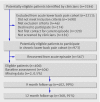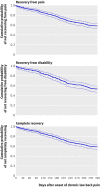Prognosis for patients with chronic low back pain: inception cohort study
- PMID: 19808766
- PMCID: PMC2758336
- DOI: 10.1136/bmj.b3829
Prognosis for patients with chronic low back pain: inception cohort study
Abstract
Objectives: To describe the course of chronic low back pain in an inception cohort and to identify prognostic markers at the onset of chronicity.
Design: Inception cohort study with one year follow-up.
Setting: Primary care clinics in Sydney, Australia.
Participants: The study sample was a subcohort of an inception cohort of 973 consecutive patients presenting to primary care with acute low back pain (<2 weeks' duration). 406 participants whose pain persisted for three months formed the inception cohort of patients with chronic low back pain.
Main outcome measures: Outcomes and putative predictors measured at initial presentation, onset of chronicity (study entry), and follow-up at nine and 12 months. Recovery was determined from measures of pain intensity, disability, and work status. The association between potential prognostic factors and time to recovery was modelled with Cox regression.
Results: Completeness of follow-up was 97% of total person time for all outcomes. The cumulative probability of being pain-free was 35% at nine months and 42% at 12 months and for complete recovery was 35% at nine months and 41% at 12 months. Of the 259 participants who had not recovered from pain related disability at entry to the chronic study, 47% had recovered by 12 months. Previous sick leave due to low back pain, high disability levels or high pain intensity at onset of chronicity, low levels of education, greater perceived risk of persistent pain, and being born outside Australia were associated with delayed recovery.
Conclusion: More than one third of patients with recent onset, non-radicular chronic low back pain recover within 12 months. The prognosis is less favourable for those who have taken previous sick leave for low back pain, have high disability levels or high pain intensity at onset of chronic low back pain, have lower education, perceive themselves as having a high risk of persistent pain, and were born outside Australia.
Conflict of interest statement
Competing interests: None declared.
Figures
Comment in
-
Prognosis of low back pain in primary care.BMJ. 2009 Oct 6;339:b3694. doi: 10.1136/bmj.b3694. BMJ. 2009. PMID: 19808764 No abstract available.
-
[Prognosis in chronic backache not as bad as assumed up to now].Praxis (Bern 1994). 2010 Mar 3;99(5):319-20. doi: 10.1024/1661-8157/a000056. Praxis (Bern 1994). 2010. PMID: 20205091 German. No abstract available.
References
-
- Mounce K. Back pain. Rheumatology 2002;41:1-5. - PubMed
-
- Walker BF. The prevalence of low back pain: a systematic review of the literature from 1966 to 1998. J Spinal Disord 2000;13:205-17. - PubMed
-
- Koes BW, van Tulder MW, Ostelo R, Kim Burton A, Waddell G. Clinical guidelines for the management of low back pain in primary care: an international comparison. Spine 2001;26:2504-13. - PubMed
-
- Van Tulder MW, Koes BW, Metsemakers JF, Bouter LM. Chronic low back pain in primary care: a prospective study on the management and course. Fam Pract 1998;15:126-32. - PubMed
Publication types
MeSH terms
LinkOut - more resources
Full Text Sources
Medical


